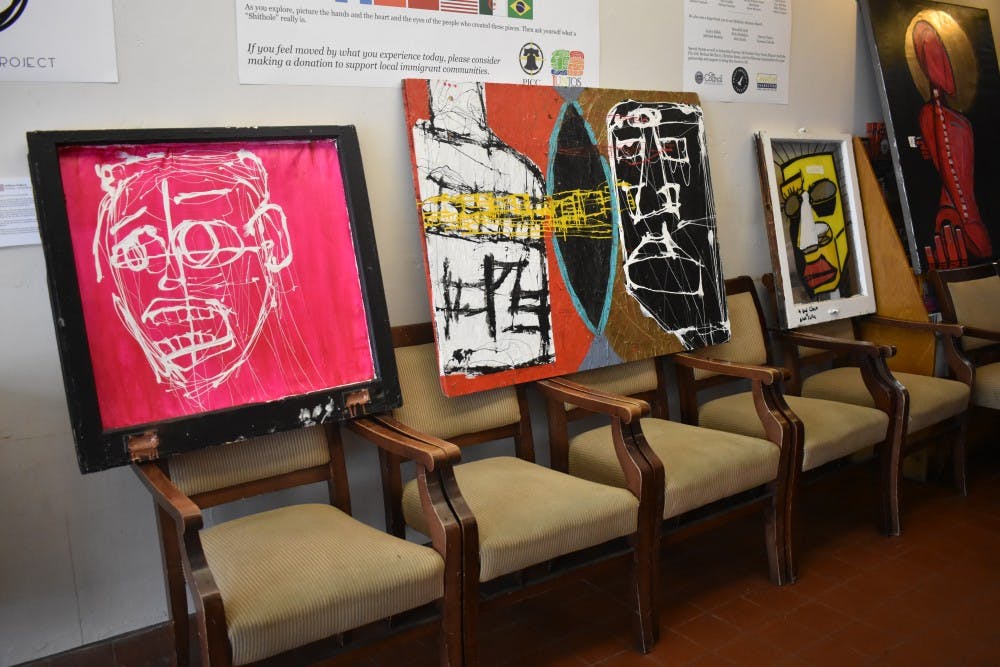Walking inside Adrienne Theater in Center City, the first sight is unlike anything I had expected. On September 28th, Le Chapeau Project held their one–day exhibition titled “Shitholes” in celebration of all of the beautiful artwork coming from countries famously described by President Trump as “shitholes.”
The first room is packed: paintings line up over a row of chairs, a seemingly indiscernible object stands a little off–center of the room, and to the back, there’s an amalgamation of color—abstract art, so to speak. The paintings on the chair are caricatures, one outlined in white set against a bright pink background and another looking rather melancholy, with its eyes shifted down. I’m not too sure what all this means, if it means anything at all, but I continue through to the next of five total rooms.

I say the first sight was unexpected because, when I walked in, there were people sitting down. In most art galleries or museums, you rarely find people hovering inches away from the art without a tape demarcating the end of allowed standing–space, let alone sitting down right in front of it. Benches in conventional museums are always at a safe distance from the artwork. However, the very people sitting so close to the art were the lead organizers, Fatène Ben–Hamza of Morocco and Steve Garguilo of Mexico, as they talked to wandering passerbys. The casual nature in which they presented themselves was a testament to the intentional accessibility of the entire exhibit. “Shitholes” was not meant to simply be a showcase of aesthetics, but also an opportunity to learn about and overcome the fundamental mischaracterizations of a number of these countries.
The second room is downstairs. Treading down the concrete staircase, I am greeted by a door with a sign indicating that the theme of this room is “Spirit.” To my immediate left is a series by Timothy Wandulu of Rwanda, the three pieces of which make up the series depicting him laughing. A collage made from news articles, the laughter is symbolic of the reaction to all the degrading things that have been said about certain countries by the administration and the media. “It’s kind of like saying ‘Honestly, I find this funny,’” Ben–Hamza described. “The best response is just to laugh at it.”
On the other side of the room is a wall of photos taken by photographer Mwarv Kirubi. The photos, to me, at first seem like any other landscape photo. But that was the point. In taking these photos, Kirubi had tried to depict South Africa just as any other picturesque country—because that’s what it is. Yes, the country has its problems, but that did not mean that it could solely be defined in terms of its shortcomings. For many, these countries were home—just as the city landscapes or pastoral greens in America are to a good chunk of us. Looking at one of the photos, “This just reminds me of what breakfast is like at home,” Ben–Hamza said. They show a sense of normalcy and a genuine interpretation of what a “shithole” country looks like to its natives.

One room over is titled “Place,” which, unsurprisingly, centers on artworks detailing specific cities or places. Set against a bright blue wall, the right–hand–side wall draws a number of different cities, such as Morocco, Casablanca, and Marrakech. They show the miniscule, often overlooked details. In one corner, a dog lays crouched down, wimpering. At the center is a large sign, welcoming visitors to whatever spectacle was occurring. The same can be said of the series in the next photo. A photograph taken by Mourad Ben Cheikh, the photo is a representation of the little streets and undervalued places in Tunis. Because Cheikh was very involved in urbex (urban exploration), he aimed to capture the hidden gems of the city. As I looked at these photos, the characterization of these countries as “shitholes” was not just misrepresentative (as I had always thought), but a polar opposite of the truth.
These were only some of the pieces of art displayed in the exhibit. The many others were aimed at uncovering the real nature of these countries, certainly not generalizable to a term of “shitholes.” It's now clear to me that the artworks in the first room were not a manifestation of some underlying theme, but of a kind of underappreciated aesthetic value from these countries. In setting up this one–day exhibit, Ben–Hamza and Garguilo have changed the way people see these countries. In response to the cutting words, they’ve reacted and done something. And whether it’s even just going to similar events or creating our own, the exhibit is our call to action to do something.

